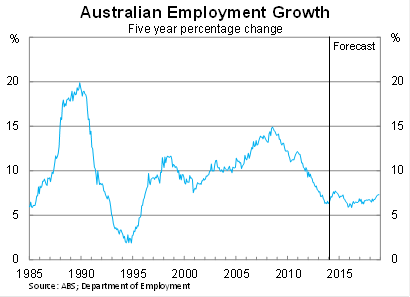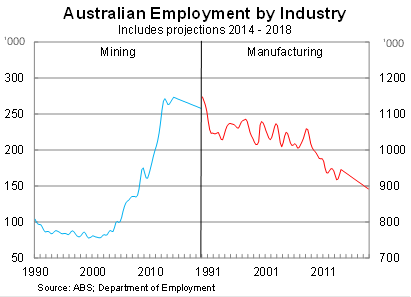The shaky foundations of the Coalition's 'powerhouse economy'
Prime Minister Tony Abbott’s vow to create an additional one million jobs over the next five years is both unambitious and yet perhaps not conservative enough.
A new report from the Department of Employment suggests that employment growth will be weak over the next five years, falling well below the Prime Minister’s target.
The Department of Employment estimates that employment will grow by 838,100 over the five years to November 2018. This figure shows growth of 7.2 per cent compared with employment in November 2013.
These numbers sit in stark contrast to the federal government’s public statements and last week The Australian revealed that ministerial advisers to Employment Minister Eric Abetz lobbied federal officials to find 160,000 new jobs to meet Abbott’s vow. Embarrassingly they were rebuffed and the original estimates were released.
However, the document itself is at pains to explain that it may understate employment growth. It notes that the projections “may not fully take account of the government’s policies to boost employment growth, including reducing red tape costs, lowering the company tax rate and abolishing the carbon and mining taxes”.
Certainly those factors may boost growth, but the report is noteworthy for two reasons: the lack of Coalition ambition and the fact that the report may still be too optimistic.
The Abbott pledge of one million jobs might sound impressive but it actually amounts to fairly subdued employment growth over the next five years. Rather than deliver strong economic growth, it would mark the lowest sustained level of employment growth since the five years up to 1996.

The estimates make a mockery of Abetz’s claim that the “Coalition will create a diverse powerhouse economy that will create one million jobs over the next five years and two million jobs over the coming decade”. The Coalition may very well create a powerhouse economy, but it will need to generate a lot more than one million jobs over the next five years.
Strictly speaking, I have no problem with the Coalition setting low expectations. Given the current demographic factors facing Australia and the uncertain outlook for the Australian economy -- in particularly the non-mining economy -- it makes sense to be conservative. But in doing so, it shouldn’t pretend to have lofty ambitions.
Unfortunately these conservative estimates may still be too ambitious for the Coalition. The industry breakdown reveals projections for the mining and manufacturing industries that may prove too optimistic.
The Department of Employment estimate that the mining sector will lose 12,300 jobs over the next five years. The mining sector is not a labour-intensive industry but with mining investment set to fall sharply, the sector is likely to cut jobs at a far faster rate.
A central problem here is that the report is based on the December 2013 Mid-Year Economic and Fiscal Outlook which, although considered too pessimistic by some critics, contains an implausibly optimistic outlook for business investment.
To give some indication of how optimistic MYEFO is with regards to mining, the National Australian Bank chief economist Alan Oster estimated that the fall in mining investment could cut up to 100,000 jobs. Some of that will involve spillovers from the mining sector, but still it points to much sharper cuts in mining sector employment.

In addition, the Department of Employment estimates that the manufacturing sector could lose 40,300 jobs over the next five years. But with investment intentions suggesting that nominal manufacturing investment could fall to its lowest level since 1992 and the death of the Australian car industry, I can easily envision a much sharper decline.
The big driver of employment growth is expected to be in healthcare and social assistance -- essentially a function of an ageing population. The Department of Employment expects those sectors to generate almost 230,000 jobs over the next five years. In general, growth will continue to be driven by the services sector.

There is an important caveat to my assessment that employment in mining and manufacturing will fall by more than expected. If it was to eventuate, it would be partly offset by other industries. Some misplaced workers would find employment elsewhere and so the economy-wide effect would be somewhat smaller.
In addition, if my less optimistic scenario were realised, then the unemployment rate would spike and I would expect some sort of stimulus from state and federal governments. This would further reduce the overall net effect.
Regardless, the Department of Employment’s projections paint a pretty bleak picture for the Australian economy over the next five years. The Coalition has tried to frame this as an ambitious employment goal but that couldn’t be further from the truth -- it is peddling a mediocre economy and pretending it’ll create a powerhouse.
If these growth targets are realised, they will lead to a further rise in the unemployment rate or a decline in labour market participation, possibly both. But perhaps the most troubling aspect to these projections is that they may, in fact, be too optimistic -- particularly for mining and manufacturing.













